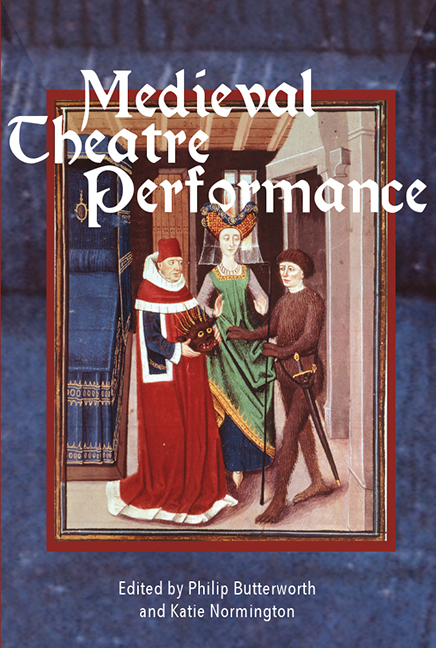Book contents
- Frontmatter
- Dedication
- Contents
- List of Illustrations
- Contributors
- Abbreviations of Principal Sources Cited
- Introduction
- Synopses
- 1 From Archive to Repertoire: The Disguising at Hertford and Performing Practices
- 2 Walk, Talk, Sit, Quit? On What Happens in Netherlandish Rhetoricians’ Plays
- 3 Performing Intrusions: Interaction and Interaxionality in Medieval English Theatre
- 4 Player Transformation: The Role of Clothing and Disguise
- 5 Pavilioned in Splendour: Performing Heaven in Fifteenth-Century Florence
- 6 Living Pictures: Drama without Text, Drama without Action
- 7 Performer-Audience Relationships in Fifteenth- and Sixteenth-century Danced Spectacles
- 8 Decadance in the Late Middle Ages: The Case of Choreomania
- 9 Writing, Telling and Showing Horsemanship in Rhetoricians’ Farce
- 10 Inanimate Performers: The Animation and Interpretive Versatility of the Palmesel
- 11 ‘lyke unto a lyvelye thyng’: The Boxley Rood of Grace and Medieval Performance
- 12 The Mechanycalle ‘Ymage off Seynt Iorge’ at St Botolph's, Billingsgate, 1474
- Bibliography
- Index
3 - Performing Intrusions: Interaction and Interaxionality in Medieval English Theatre
Published online by Cambridge University Press: 21 August 2018
- Frontmatter
- Dedication
- Contents
- List of Illustrations
- Contributors
- Abbreviations of Principal Sources Cited
- Introduction
- Synopses
- 1 From Archive to Repertoire: The Disguising at Hertford and Performing Practices
- 2 Walk, Talk, Sit, Quit? On What Happens in Netherlandish Rhetoricians’ Plays
- 3 Performing Intrusions: Interaction and Interaxionality in Medieval English Theatre
- 4 Player Transformation: The Role of Clothing and Disguise
- 5 Pavilioned in Splendour: Performing Heaven in Fifteenth-Century Florence
- 6 Living Pictures: Drama without Text, Drama without Action
- 7 Performer-Audience Relationships in Fifteenth- and Sixteenth-century Danced Spectacles
- 8 Decadance in the Late Middle Ages: The Case of Choreomania
- 9 Writing, Telling and Showing Horsemanship in Rhetoricians’ Farce
- 10 Inanimate Performers: The Animation and Interpretive Versatility of the Palmesel
- 11 ‘lyke unto a lyvelye thyng’: The Boxley Rood of Grace and Medieval Performance
- 12 The Mechanycalle ‘Ymage off Seynt Iorge’ at St Botolph's, Billingsgate, 1474
- Bibliography
- Index
Summary
In significant recent work, Claire Sponsler has urged for a more appropriate balance between literary and theatrical approaches to medieval drama, and offered an exemplary instance of how the latter should properly encompass varieties of performance culture whose material and institutional auspices do not altogether match ‘theatre’ as conventionally understood. In seeking to further such a ‘breakthrough into performance’, as it was called when something similar happened in Folklore studies, what follows will also, as it happens, engage with the late medieval ‘mummings’ or ‘disguisings’ which loom large among the materials Sponsler studies, and for which indeed there is sometimes ‘no room’ in standard surveys. However, they will here be studied, not directly, but in the form of ‘intrusions’ (the first connotation of the term in my title) into larger dramatic productions. In this instance, rather than of interest in their own right, they have a strictly subordinate function as an effective illustration of this chapter's broader thesis, which is that the study of early performance culture might benefit from deploying an action-orientated analogue of the concept of ‘intertextuality’ that is well established in analysing the relationships between literary texts: I suggest, based on the same model, we term it ‘interaxionality’.
Rather than considering dramatic texts, interaxionality encompasses the performance aspects of drama, such as the appearance (dress, posture, facial expression), gesticulation, and movement of performers, their interaction with each other, with the performance space, and sometimes with spectators. From this perspective, words spoken in performance are downgraded from their literary pedestal as the essence of drama (which can be supported by action), to the humbler status of vocal auxiliaries to action, although they can often have the added value of indicating action (‘Come let us …’; ‘See how he …’) which may not be registered in explicit stage directions. And of course interaxionality also encompasses, as intertextuality cannot, both sequences of unscripted performance lacking a vocal element, and indeed entire forms, like dumb shows and some types of mumming, which are wordless.
- Type
- Chapter
- Information
- Medieval Theatre PerformanceActors, Dancers, Automata and their Audiences, pp. 52 - 75Publisher: Boydell & BrewerPrint publication year: 2017



